AJ's SHRM Essay: Performance-Based Pay and Global Training
VerifiedAdded on 2020/06/03
|11
|3756
|146
Essay
AI Summary
This essay delves into two key aspects of strategic human resource management (SHRM): performance-based pay and global training. The first part examines performance-based pay as a motivational tool, analyzing its impact on employee motivation, productivity, and organizational goals. It discusses the benefits, challenges, and criticisms of individual performance-related pay (IPRP), considering factors like reward systems, appraisal methods, and potential for rivalry. The second part focuses on global training strategies, highlighting the importance of preparing employees for international assignments. It outlines various training approaches, including language training, cross-cultural awareness, and understanding cultural differences, to ensure successful global operations and effective employee performance in diverse cultural contexts.
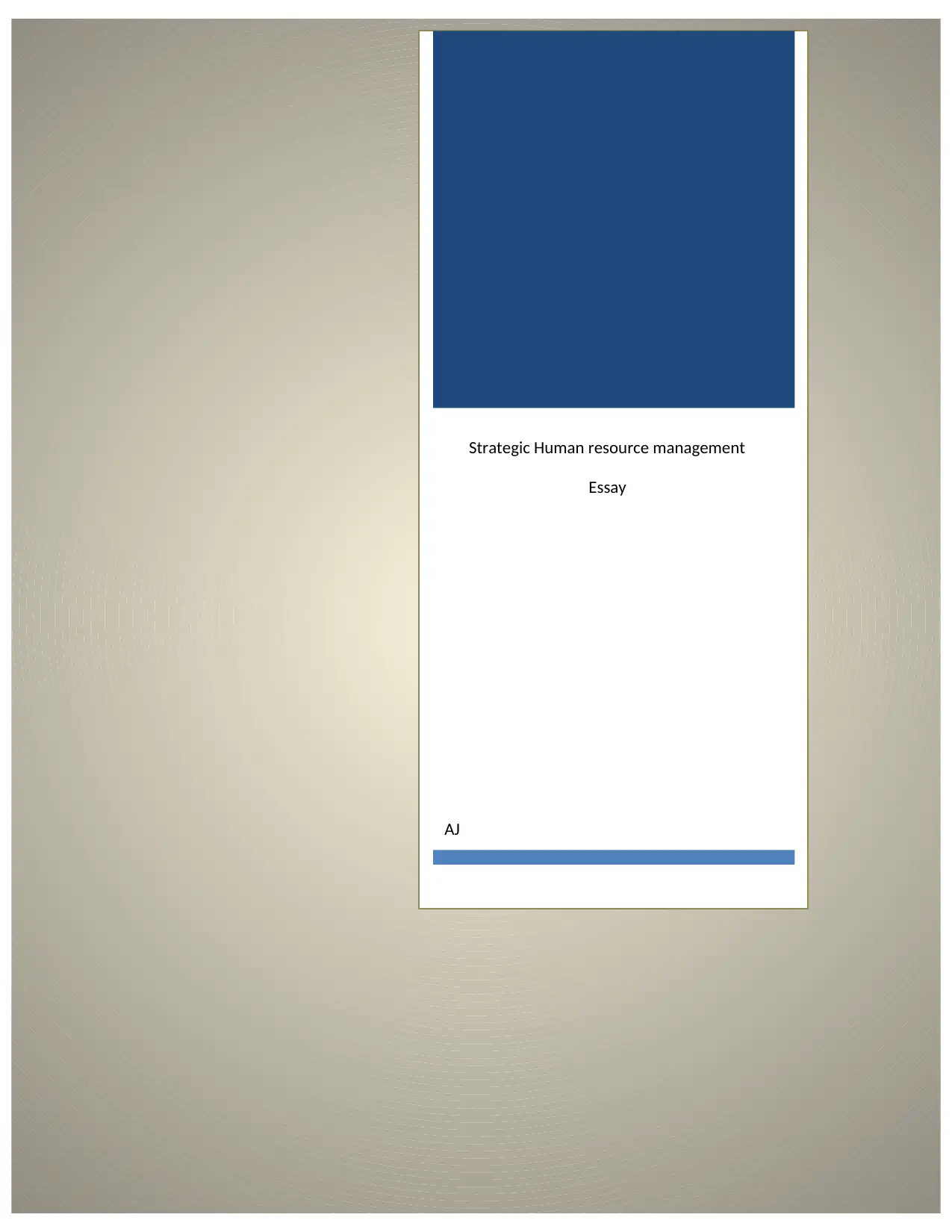
Strategic Human resource management
Essay
AJ
Essay
AJ
Paraphrase This Document
Need a fresh take? Get an instant paraphrase of this document with our AI Paraphraser
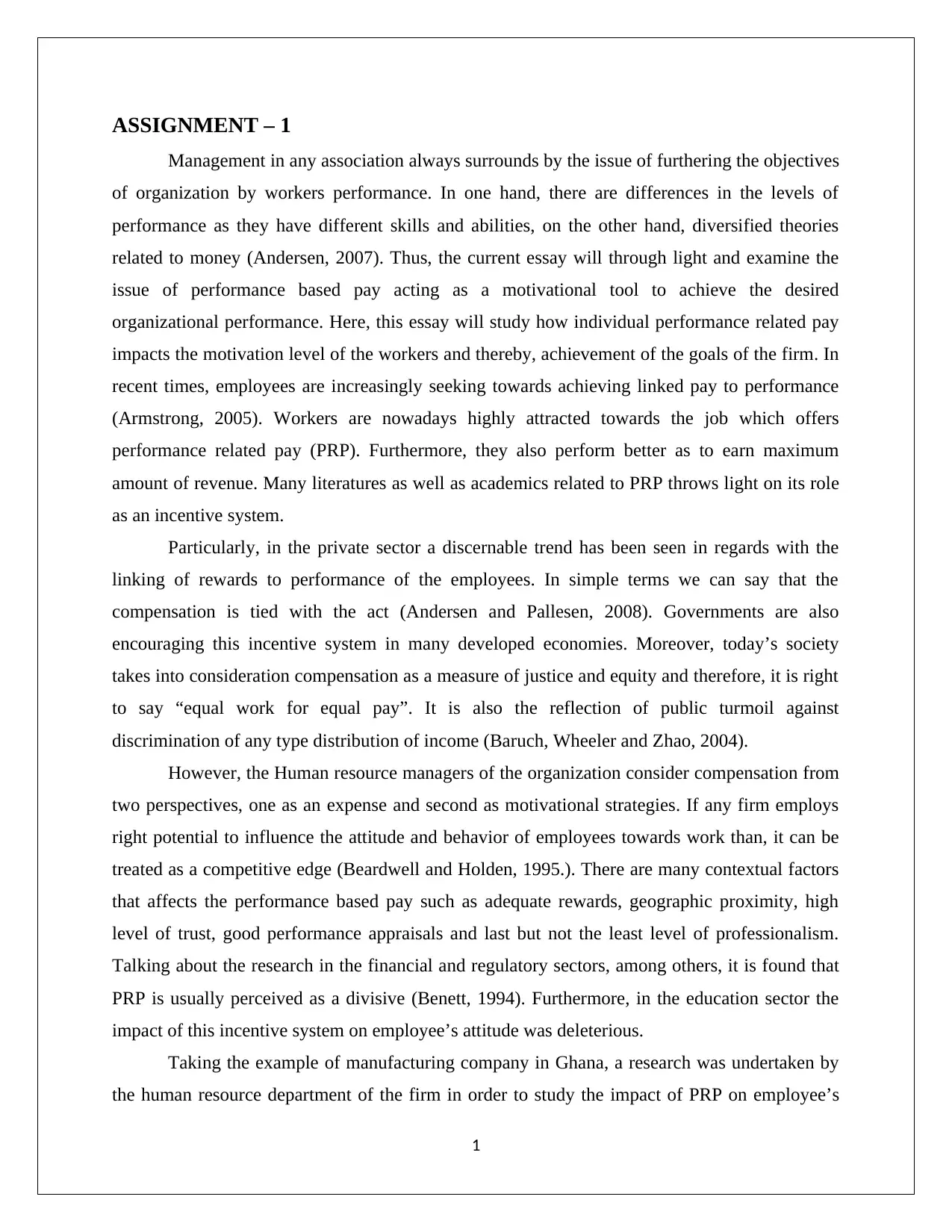
ASSIGNMENT – 1
Management in any association always surrounds by the issue of furthering the objectives
of organization by workers performance. In one hand, there are differences in the levels of
performance as they have different skills and abilities, on the other hand, diversified theories
related to money (Andersen, 2007). Thus, the current essay will through light and examine the
issue of performance based pay acting as a motivational tool to achieve the desired
organizational performance. Here, this essay will study how individual performance related pay
impacts the motivation level of the workers and thereby, achievement of the goals of the firm. In
recent times, employees are increasingly seeking towards achieving linked pay to performance
(Armstrong, 2005). Workers are nowadays highly attracted towards the job which offers
performance related pay (PRP). Furthermore, they also perform better as to earn maximum
amount of revenue. Many literatures as well as academics related to PRP throws light on its role
as an incentive system.
Particularly, in the private sector a discernable trend has been seen in regards with the
linking of rewards to performance of the employees. In simple terms we can say that the
compensation is tied with the act (Andersen and Pallesen, 2008). Governments are also
encouraging this incentive system in many developed economies. Moreover, today’s society
takes into consideration compensation as a measure of justice and equity and therefore, it is right
to say “equal work for equal pay”. It is also the reflection of public turmoil against
discrimination of any type distribution of income (Baruch, Wheeler and Zhao, 2004).
However, the Human resource managers of the organization consider compensation from
two perspectives, one as an expense and second as motivational strategies. If any firm employs
right potential to influence the attitude and behavior of employees towards work than, it can be
treated as a competitive edge (Beardwell and Holden, 1995.). There are many contextual factors
that affects the performance based pay such as adequate rewards, geographic proximity, high
level of trust, good performance appraisals and last but not the least level of professionalism.
Talking about the research in the financial and regulatory sectors, among others, it is found that
PRP is usually perceived as a divisive (Benett, 1994). Furthermore, in the education sector the
impact of this incentive system on employee’s attitude was deleterious.
Taking the example of manufacturing company in Ghana, a research was undertaken by
the human resource department of the firm in order to study the impact of PRP on employee’s
1
Management in any association always surrounds by the issue of furthering the objectives
of organization by workers performance. In one hand, there are differences in the levels of
performance as they have different skills and abilities, on the other hand, diversified theories
related to money (Andersen, 2007). Thus, the current essay will through light and examine the
issue of performance based pay acting as a motivational tool to achieve the desired
organizational performance. Here, this essay will study how individual performance related pay
impacts the motivation level of the workers and thereby, achievement of the goals of the firm. In
recent times, employees are increasingly seeking towards achieving linked pay to performance
(Armstrong, 2005). Workers are nowadays highly attracted towards the job which offers
performance related pay (PRP). Furthermore, they also perform better as to earn maximum
amount of revenue. Many literatures as well as academics related to PRP throws light on its role
as an incentive system.
Particularly, in the private sector a discernable trend has been seen in regards with the
linking of rewards to performance of the employees. In simple terms we can say that the
compensation is tied with the act (Andersen and Pallesen, 2008). Governments are also
encouraging this incentive system in many developed economies. Moreover, today’s society
takes into consideration compensation as a measure of justice and equity and therefore, it is right
to say “equal work for equal pay”. It is also the reflection of public turmoil against
discrimination of any type distribution of income (Baruch, Wheeler and Zhao, 2004).
However, the Human resource managers of the organization consider compensation from
two perspectives, one as an expense and second as motivational strategies. If any firm employs
right potential to influence the attitude and behavior of employees towards work than, it can be
treated as a competitive edge (Beardwell and Holden, 1995.). There are many contextual factors
that affects the performance based pay such as adequate rewards, geographic proximity, high
level of trust, good performance appraisals and last but not the least level of professionalism.
Talking about the research in the financial and regulatory sectors, among others, it is found that
PRP is usually perceived as a divisive (Benett, 1994). Furthermore, in the education sector the
impact of this incentive system on employee’s attitude was deleterious.
Taking the example of manufacturing company in Ghana, a research was undertaken by
the human resource department of the firm in order to study the impact of PRP on employee’s
1
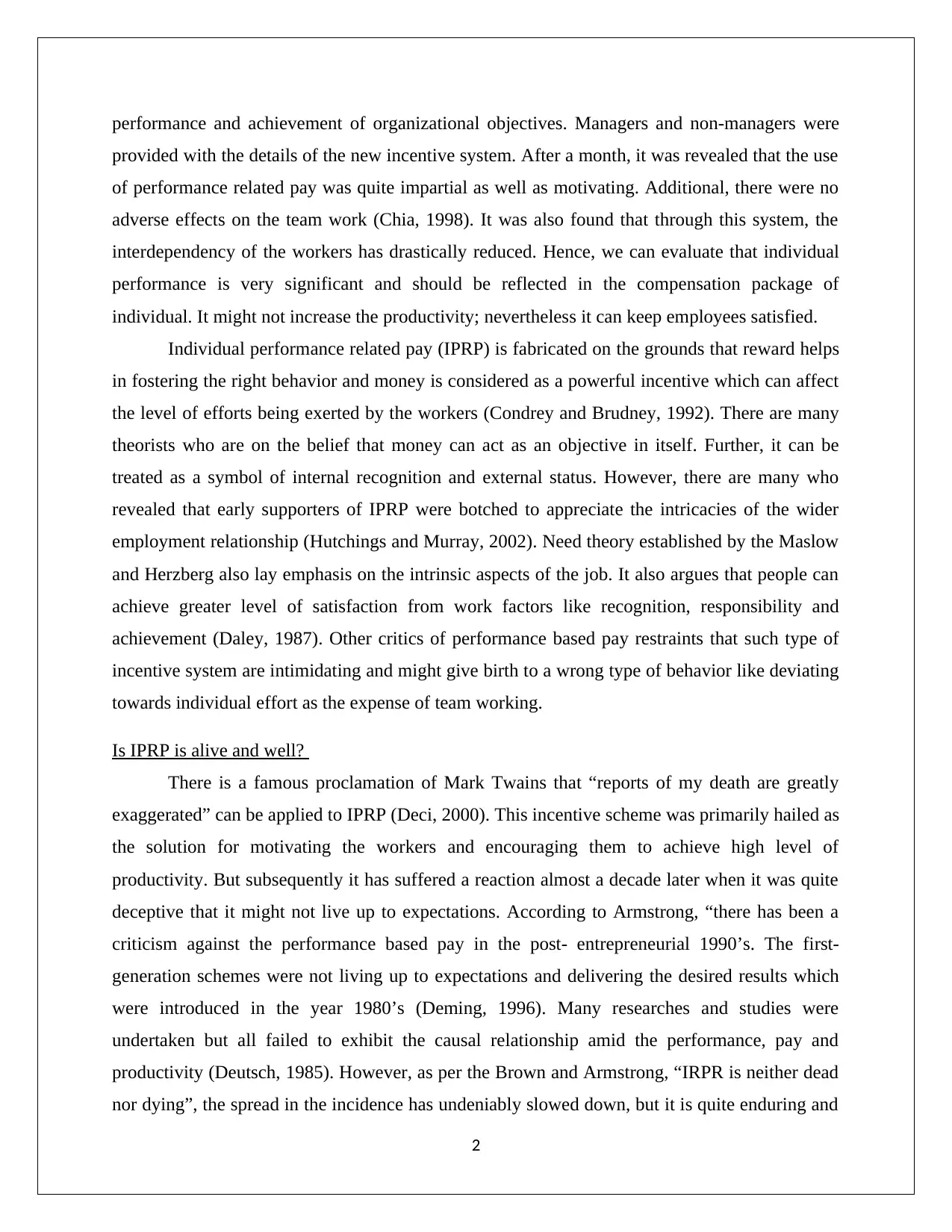
performance and achievement of organizational objectives. Managers and non-managers were
provided with the details of the new incentive system. After a month, it was revealed that the use
of performance related pay was quite impartial as well as motivating. Additional, there were no
adverse effects on the team work (Chia, 1998). It was also found that through this system, the
interdependency of the workers has drastically reduced. Hence, we can evaluate that individual
performance is very significant and should be reflected in the compensation package of
individual. It might not increase the productivity; nevertheless it can keep employees satisfied.
Individual performance related pay (IPRP) is fabricated on the grounds that reward helps
in fostering the right behavior and money is considered as a powerful incentive which can affect
the level of efforts being exerted by the workers (Condrey and Brudney, 1992). There are many
theorists who are on the belief that money can act as an objective in itself. Further, it can be
treated as a symbol of internal recognition and external status. However, there are many who
revealed that early supporters of IPRP were botched to appreciate the intricacies of the wider
employment relationship (Hutchings and Murray, 2002). Need theory established by the Maslow
and Herzberg also lay emphasis on the intrinsic aspects of the job. It also argues that people can
achieve greater level of satisfaction from work factors like recognition, responsibility and
achievement (Daley, 1987). Other critics of performance based pay restraints that such type of
incentive system are intimidating and might give birth to a wrong type of behavior like deviating
towards individual effort as the expense of team working.
Is IPRP is alive and well?
There is a famous proclamation of Mark Twains that “reports of my death are greatly
exaggerated” can be applied to IPRP (Deci, 2000). This incentive scheme was primarily hailed as
the solution for motivating the workers and encouraging them to achieve high level of
productivity. But subsequently it has suffered a reaction almost a decade later when it was quite
deceptive that it might not live up to expectations. According to Armstrong, “there has been a
criticism against the performance based pay in the post- entrepreneurial 1990’s. The first-
generation schemes were not living up to expectations and delivering the desired results which
were introduced in the year 1980’s (Deming, 1996). Many researches and studies were
undertaken but all failed to exhibit the causal relationship amid the performance, pay and
productivity (Deutsch, 1985). However, as per the Brown and Armstrong, “IRPR is neither dead
nor dying”, the spread in the incidence has undeniably slowed down, but it is quite enduring and
2
provided with the details of the new incentive system. After a month, it was revealed that the use
of performance related pay was quite impartial as well as motivating. Additional, there were no
adverse effects on the team work (Chia, 1998). It was also found that through this system, the
interdependency of the workers has drastically reduced. Hence, we can evaluate that individual
performance is very significant and should be reflected in the compensation package of
individual. It might not increase the productivity; nevertheless it can keep employees satisfied.
Individual performance related pay (IPRP) is fabricated on the grounds that reward helps
in fostering the right behavior and money is considered as a powerful incentive which can affect
the level of efforts being exerted by the workers (Condrey and Brudney, 1992). There are many
theorists who are on the belief that money can act as an objective in itself. Further, it can be
treated as a symbol of internal recognition and external status. However, there are many who
revealed that early supporters of IPRP were botched to appreciate the intricacies of the wider
employment relationship (Hutchings and Murray, 2002). Need theory established by the Maslow
and Herzberg also lay emphasis on the intrinsic aspects of the job. It also argues that people can
achieve greater level of satisfaction from work factors like recognition, responsibility and
achievement (Daley, 1987). Other critics of performance based pay restraints that such type of
incentive system are intimidating and might give birth to a wrong type of behavior like deviating
towards individual effort as the expense of team working.
Is IPRP is alive and well?
There is a famous proclamation of Mark Twains that “reports of my death are greatly
exaggerated” can be applied to IPRP (Deci, 2000). This incentive scheme was primarily hailed as
the solution for motivating the workers and encouraging them to achieve high level of
productivity. But subsequently it has suffered a reaction almost a decade later when it was quite
deceptive that it might not live up to expectations. According to Armstrong, “there has been a
criticism against the performance based pay in the post- entrepreneurial 1990’s. The first-
generation schemes were not living up to expectations and delivering the desired results which
were introduced in the year 1980’s (Deming, 1996). Many researches and studies were
undertaken but all failed to exhibit the causal relationship amid the performance, pay and
productivity (Deutsch, 1985). However, as per the Brown and Armstrong, “IRPR is neither dead
nor dying”, the spread in the incidence has undeniably slowed down, but it is quite enduring and
2
⊘ This is a preview!⊘
Do you want full access?
Subscribe today to unlock all pages.

Trusted by 1+ million students worldwide
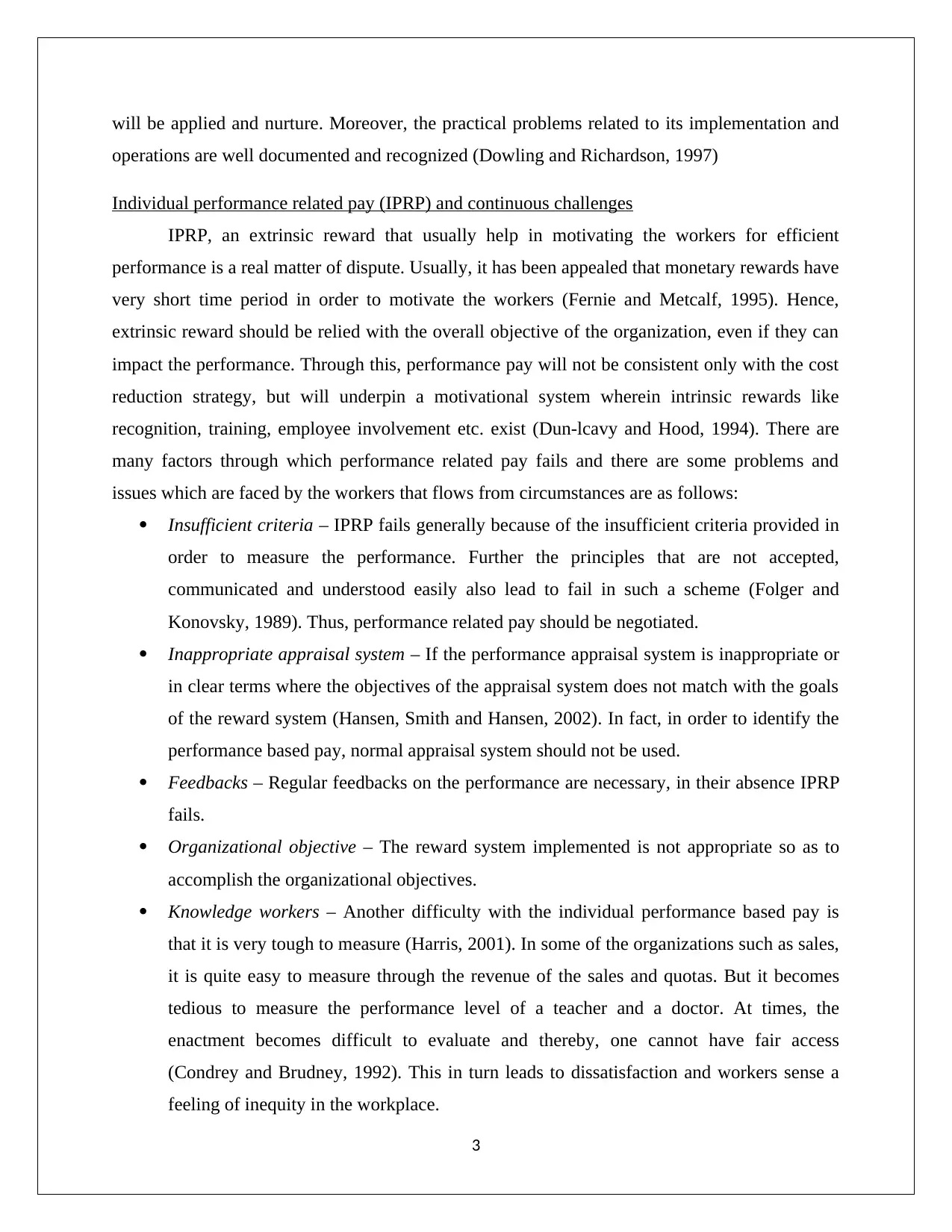
will be applied and nurture. Moreover, the practical problems related to its implementation and
operations are well documented and recognized (Dowling and Richardson, 1997)
Individual performance related pay (IPRP) and continuous challenges
IPRP, an extrinsic reward that usually help in motivating the workers for efficient
performance is a real matter of dispute. Usually, it has been appealed that monetary rewards have
very short time period in order to motivate the workers (Fernie and Metcalf, 1995). Hence,
extrinsic reward should be relied with the overall objective of the organization, even if they can
impact the performance. Through this, performance pay will not be consistent only with the cost
reduction strategy, but will underpin a motivational system wherein intrinsic rewards like
recognition, training, employee involvement etc. exist (Dun-lcavy and Hood, 1994). There are
many factors through which performance related pay fails and there are some problems and
issues which are faced by the workers that flows from circumstances are as follows:
Insufficient criteria – IPRP fails generally because of the insufficient criteria provided in
order to measure the performance. Further the principles that are not accepted,
communicated and understood easily also lead to fail in such a scheme (Folger and
Konovsky, 1989). Thus, performance related pay should be negotiated.
Inappropriate appraisal system – If the performance appraisal system is inappropriate or
in clear terms where the objectives of the appraisal system does not match with the goals
of the reward system (Hansen, Smith and Hansen, 2002). In fact, in order to identify the
performance based pay, normal appraisal system should not be used.
Feedbacks – Regular feedbacks on the performance are necessary, in their absence IPRP
fails.
Organizational objective – The reward system implemented is not appropriate so as to
accomplish the organizational objectives.
Knowledge workers – Another difficulty with the individual performance based pay is
that it is very tough to measure (Harris, 2001). In some of the organizations such as sales,
it is quite easy to measure through the revenue of the sales and quotas. But it becomes
tedious to measure the performance level of a teacher and a doctor. At times, the
enactment becomes difficult to evaluate and thereby, one cannot have fair access
(Condrey and Brudney, 1992). This in turn leads to dissatisfaction and workers sense a
feeling of inequity in the workplace.
3
operations are well documented and recognized (Dowling and Richardson, 1997)
Individual performance related pay (IPRP) and continuous challenges
IPRP, an extrinsic reward that usually help in motivating the workers for efficient
performance is a real matter of dispute. Usually, it has been appealed that monetary rewards have
very short time period in order to motivate the workers (Fernie and Metcalf, 1995). Hence,
extrinsic reward should be relied with the overall objective of the organization, even if they can
impact the performance. Through this, performance pay will not be consistent only with the cost
reduction strategy, but will underpin a motivational system wherein intrinsic rewards like
recognition, training, employee involvement etc. exist (Dun-lcavy and Hood, 1994). There are
many factors through which performance related pay fails and there are some problems and
issues which are faced by the workers that flows from circumstances are as follows:
Insufficient criteria – IPRP fails generally because of the insufficient criteria provided in
order to measure the performance. Further the principles that are not accepted,
communicated and understood easily also lead to fail in such a scheme (Folger and
Konovsky, 1989). Thus, performance related pay should be negotiated.
Inappropriate appraisal system – If the performance appraisal system is inappropriate or
in clear terms where the objectives of the appraisal system does not match with the goals
of the reward system (Hansen, Smith and Hansen, 2002). In fact, in order to identify the
performance based pay, normal appraisal system should not be used.
Feedbacks – Regular feedbacks on the performance are necessary, in their absence IPRP
fails.
Organizational objective – The reward system implemented is not appropriate so as to
accomplish the organizational objectives.
Knowledge workers – Another difficulty with the individual performance based pay is
that it is very tough to measure (Harris, 2001). In some of the organizations such as sales,
it is quite easy to measure through the revenue of the sales and quotas. But it becomes
tedious to measure the performance level of a teacher and a doctor. At times, the
enactment becomes difficult to evaluate and thereby, one cannot have fair access
(Condrey and Brudney, 1992). This in turn leads to dissatisfaction and workers sense a
feeling of inequity in the workplace.
3
Paraphrase This Document
Need a fresh take? Get an instant paraphrase of this document with our AI Paraphraser
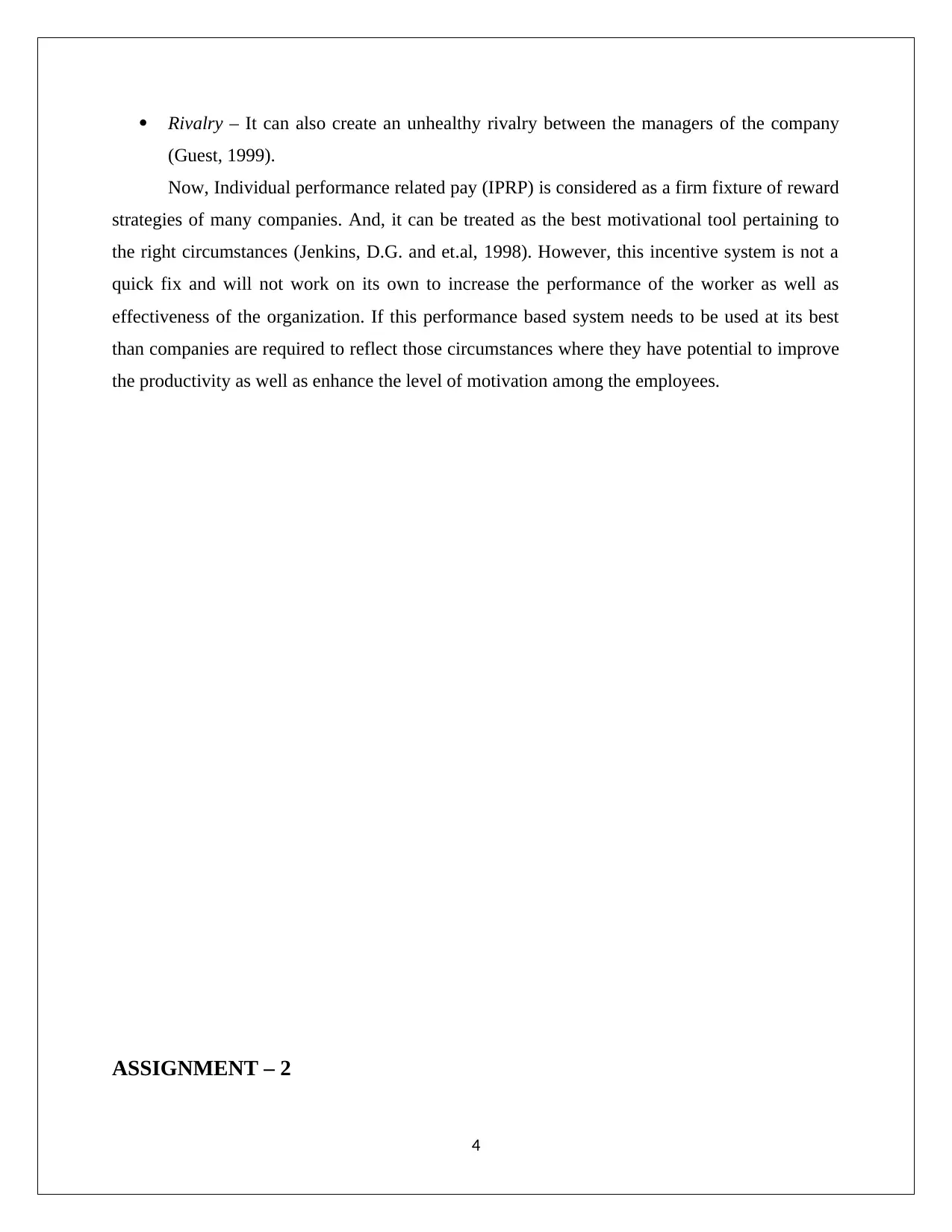
Rivalry – It can also create an unhealthy rivalry between the managers of the company
(Guest, 1999).
Now, Individual performance related pay (IPRP) is considered as a firm fixture of reward
strategies of many companies. And, it can be treated as the best motivational tool pertaining to
the right circumstances (Jenkins, D.G. and et.al, 1998). However, this incentive system is not a
quick fix and will not work on its own to increase the performance of the worker as well as
effectiveness of the organization. If this performance based system needs to be used at its best
than companies are required to reflect those circumstances where they have potential to improve
the productivity as well as enhance the level of motivation among the employees.
ASSIGNMENT – 2
4
(Guest, 1999).
Now, Individual performance related pay (IPRP) is considered as a firm fixture of reward
strategies of many companies. And, it can be treated as the best motivational tool pertaining to
the right circumstances (Jenkins, D.G. and et.al, 1998). However, this incentive system is not a
quick fix and will not work on its own to increase the performance of the worker as well as
effectiveness of the organization. If this performance based system needs to be used at its best
than companies are required to reflect those circumstances where they have potential to improve
the productivity as well as enhance the level of motivation among the employees.
ASSIGNMENT – 2
4
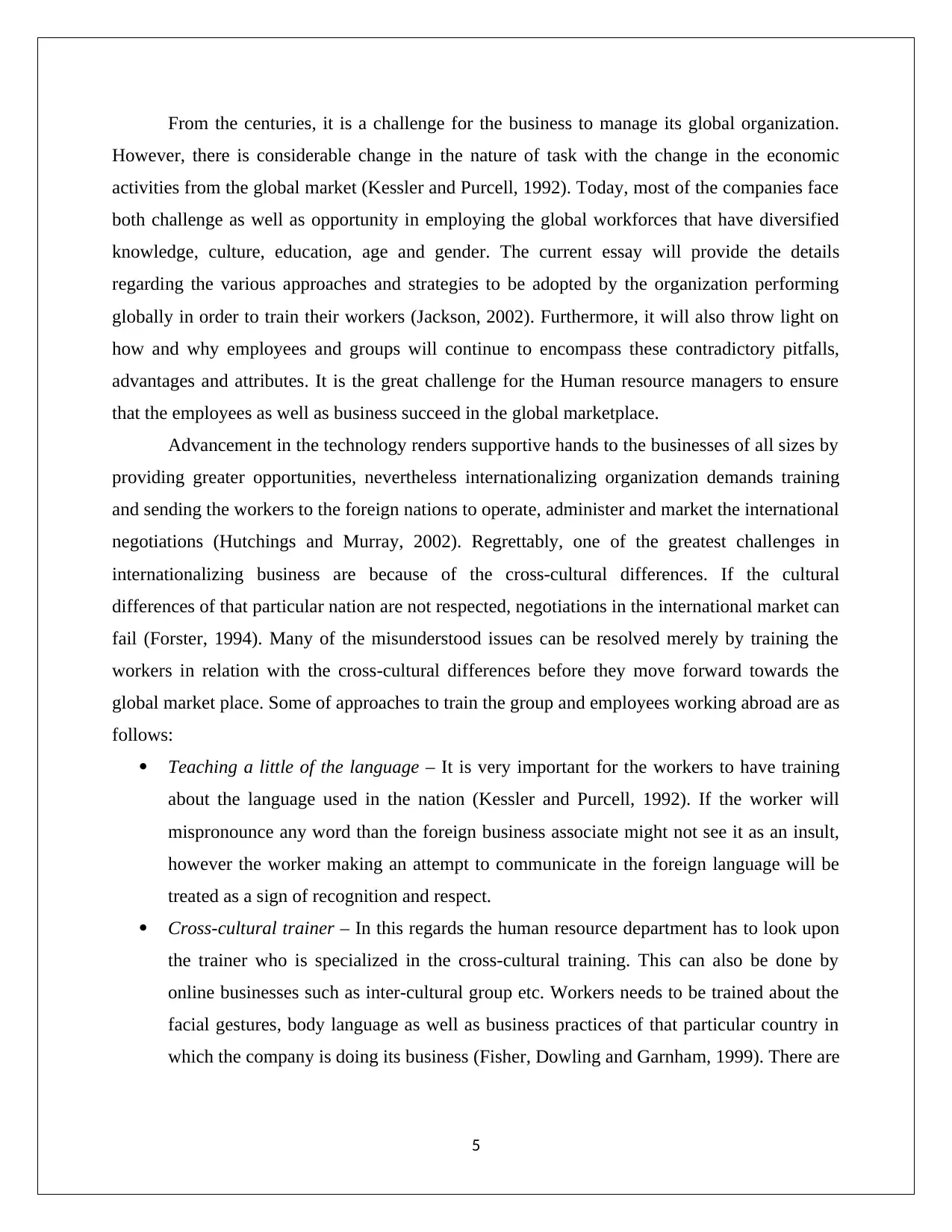
From the centuries, it is a challenge for the business to manage its global organization.
However, there is considerable change in the nature of task with the change in the economic
activities from the global market (Kessler and Purcell, 1992). Today, most of the companies face
both challenge as well as opportunity in employing the global workforces that have diversified
knowledge, culture, education, age and gender. The current essay will provide the details
regarding the various approaches and strategies to be adopted by the organization performing
globally in order to train their workers (Jackson, 2002). Furthermore, it will also throw light on
how and why employees and groups will continue to encompass these contradictory pitfalls,
advantages and attributes. It is the great challenge for the Human resource managers to ensure
that the employees as well as business succeed in the global marketplace.
Advancement in the technology renders supportive hands to the businesses of all sizes by
providing greater opportunities, nevertheless internationalizing organization demands training
and sending the workers to the foreign nations to operate, administer and market the international
negotiations (Hutchings and Murray, 2002). Regrettably, one of the greatest challenges in
internationalizing business are because of the cross-cultural differences. If the cultural
differences of that particular nation are not respected, negotiations in the international market can
fail (Forster, 1994). Many of the misunderstood issues can be resolved merely by training the
workers in relation with the cross-cultural differences before they move forward towards the
global market place. Some of approaches to train the group and employees working abroad are as
follows:
Teaching a little of the language – It is very important for the workers to have training
about the language used in the nation (Kessler and Purcell, 1992). If the worker will
mispronounce any word than the foreign business associate might not see it as an insult,
however the worker making an attempt to communicate in the foreign language will be
treated as a sign of recognition and respect.
Cross-cultural trainer – In this regards the human resource department has to look upon
the trainer who is specialized in the cross-cultural training. This can also be done by
online businesses such as inter-cultural group etc. Workers needs to be trained about the
facial gestures, body language as well as business practices of that particular country in
which the company is doing its business (Fisher, Dowling and Garnham, 1999). There are
5
However, there is considerable change in the nature of task with the change in the economic
activities from the global market (Kessler and Purcell, 1992). Today, most of the companies face
both challenge as well as opportunity in employing the global workforces that have diversified
knowledge, culture, education, age and gender. The current essay will provide the details
regarding the various approaches and strategies to be adopted by the organization performing
globally in order to train their workers (Jackson, 2002). Furthermore, it will also throw light on
how and why employees and groups will continue to encompass these contradictory pitfalls,
advantages and attributes. It is the great challenge for the Human resource managers to ensure
that the employees as well as business succeed in the global marketplace.
Advancement in the technology renders supportive hands to the businesses of all sizes by
providing greater opportunities, nevertheless internationalizing organization demands training
and sending the workers to the foreign nations to operate, administer and market the international
negotiations (Hutchings and Murray, 2002). Regrettably, one of the greatest challenges in
internationalizing business are because of the cross-cultural differences. If the cultural
differences of that particular nation are not respected, negotiations in the international market can
fail (Forster, 1994). Many of the misunderstood issues can be resolved merely by training the
workers in relation with the cross-cultural differences before they move forward towards the
global market place. Some of approaches to train the group and employees working abroad are as
follows:
Teaching a little of the language – It is very important for the workers to have training
about the language used in the nation (Kessler and Purcell, 1992). If the worker will
mispronounce any word than the foreign business associate might not see it as an insult,
however the worker making an attempt to communicate in the foreign language will be
treated as a sign of recognition and respect.
Cross-cultural trainer – In this regards the human resource department has to look upon
the trainer who is specialized in the cross-cultural training. This can also be done by
online businesses such as inter-cultural group etc. Workers needs to be trained about the
facial gestures, body language as well as business practices of that particular country in
which the company is doing its business (Fisher, Dowling and Garnham, 1999). There are
5
⊘ This is a preview!⊘
Do you want full access?
Subscribe today to unlock all pages.

Trusted by 1+ million students worldwide
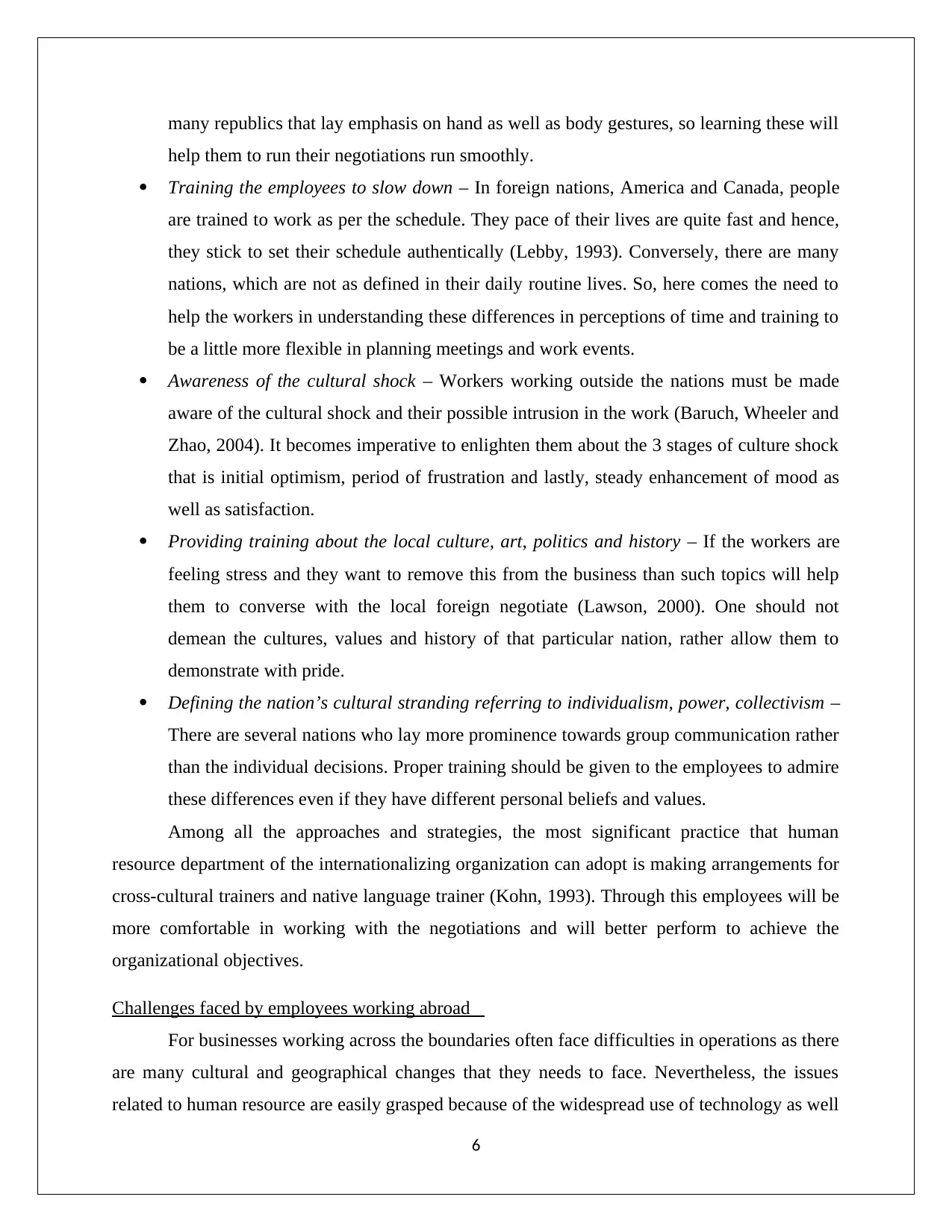
many republics that lay emphasis on hand as well as body gestures, so learning these will
help them to run their negotiations run smoothly.
Training the employees to slow down – In foreign nations, America and Canada, people
are trained to work as per the schedule. They pace of their lives are quite fast and hence,
they stick to set their schedule authentically (Lebby, 1993). Conversely, there are many
nations, which are not as defined in their daily routine lives. So, here comes the need to
help the workers in understanding these differences in perceptions of time and training to
be a little more flexible in planning meetings and work events.
Awareness of the cultural shock – Workers working outside the nations must be made
aware of the cultural shock and their possible intrusion in the work (Baruch, Wheeler and
Zhao, 2004). It becomes imperative to enlighten them about the 3 stages of culture shock
that is initial optimism, period of frustration and lastly, steady enhancement of mood as
well as satisfaction.
Providing training about the local culture, art, politics and history – If the workers are
feeling stress and they want to remove this from the business than such topics will help
them to converse with the local foreign negotiate (Lawson, 2000). One should not
demean the cultures, values and history of that particular nation, rather allow them to
demonstrate with pride.
Defining the nation’s cultural stranding referring to individualism, power, collectivism –
There are several nations who lay more prominence towards group communication rather
than the individual decisions. Proper training should be given to the employees to admire
these differences even if they have different personal beliefs and values.
Among all the approaches and strategies, the most significant practice that human
resource department of the internationalizing organization can adopt is making arrangements for
cross-cultural trainers and native language trainer (Kohn, 1993). Through this employees will be
more comfortable in working with the negotiations and will better perform to achieve the
organizational objectives.
Challenges faced by employees working abroad
For businesses working across the boundaries often face difficulties in operations as there
are many cultural and geographical changes that they needs to face. Nevertheless, the issues
related to human resource are easily grasped because of the widespread use of technology as well
6
help them to run their negotiations run smoothly.
Training the employees to slow down – In foreign nations, America and Canada, people
are trained to work as per the schedule. They pace of their lives are quite fast and hence,
they stick to set their schedule authentically (Lebby, 1993). Conversely, there are many
nations, which are not as defined in their daily routine lives. So, here comes the need to
help the workers in understanding these differences in perceptions of time and training to
be a little more flexible in planning meetings and work events.
Awareness of the cultural shock – Workers working outside the nations must be made
aware of the cultural shock and their possible intrusion in the work (Baruch, Wheeler and
Zhao, 2004). It becomes imperative to enlighten them about the 3 stages of culture shock
that is initial optimism, period of frustration and lastly, steady enhancement of mood as
well as satisfaction.
Providing training about the local culture, art, politics and history – If the workers are
feeling stress and they want to remove this from the business than such topics will help
them to converse with the local foreign negotiate (Lawson, 2000). One should not
demean the cultures, values and history of that particular nation, rather allow them to
demonstrate with pride.
Defining the nation’s cultural stranding referring to individualism, power, collectivism –
There are several nations who lay more prominence towards group communication rather
than the individual decisions. Proper training should be given to the employees to admire
these differences even if they have different personal beliefs and values.
Among all the approaches and strategies, the most significant practice that human
resource department of the internationalizing organization can adopt is making arrangements for
cross-cultural trainers and native language trainer (Kohn, 1993). Through this employees will be
more comfortable in working with the negotiations and will better perform to achieve the
organizational objectives.
Challenges faced by employees working abroad
For businesses working across the boundaries often face difficulties in operations as there
are many cultural and geographical changes that they needs to face. Nevertheless, the issues
related to human resource are easily grasped because of the widespread use of technology as well
6
Paraphrase This Document
Need a fresh take? Get an instant paraphrase of this document with our AI Paraphraser
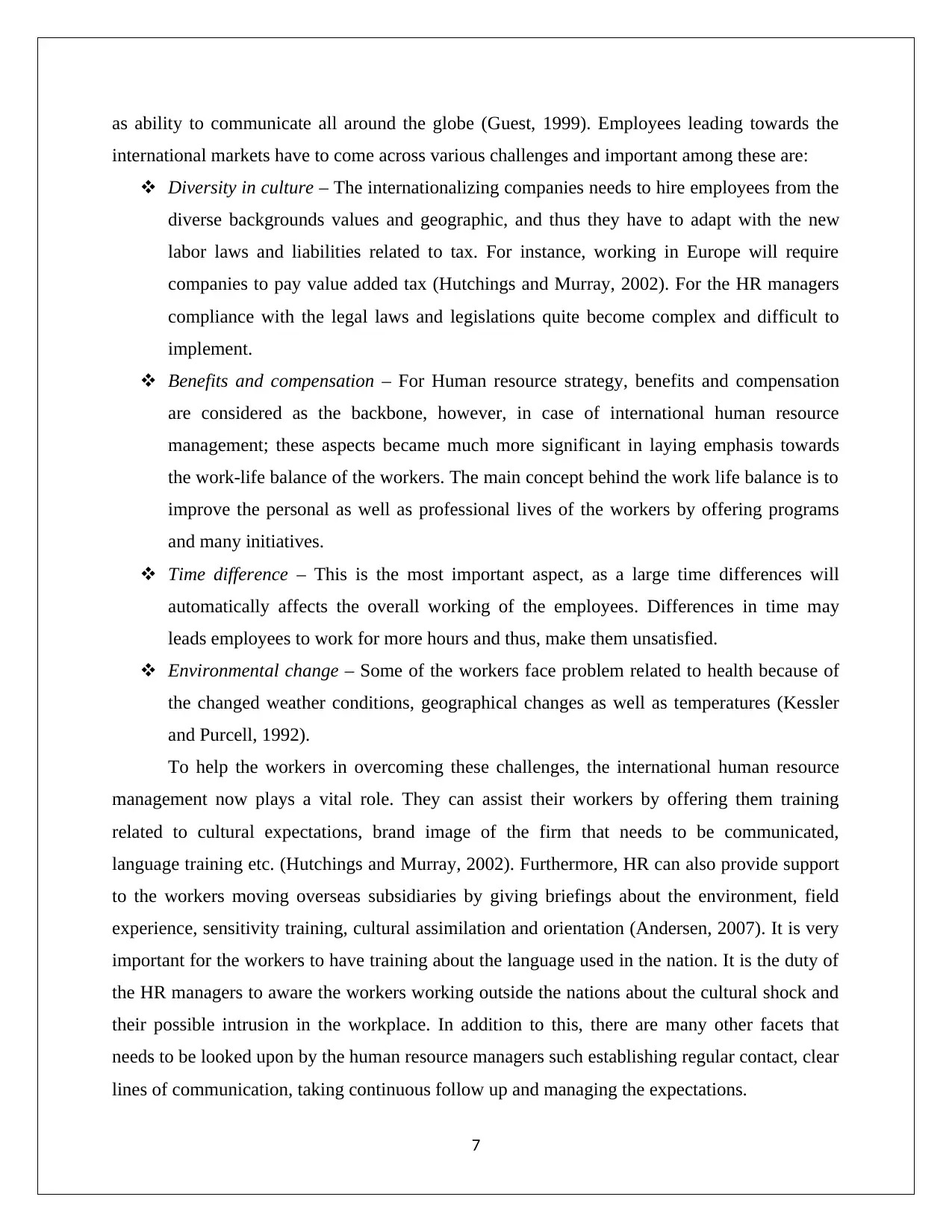
as ability to communicate all around the globe (Guest, 1999). Employees leading towards the
international markets have to come across various challenges and important among these are:
Diversity in culture – The internationalizing companies needs to hire employees from the
diverse backgrounds values and geographic, and thus they have to adapt with the new
labor laws and liabilities related to tax. For instance, working in Europe will require
companies to pay value added tax (Hutchings and Murray, 2002). For the HR managers
compliance with the legal laws and legislations quite become complex and difficult to
implement.
Benefits and compensation – For Human resource strategy, benefits and compensation
are considered as the backbone, however, in case of international human resource
management; these aspects became much more significant in laying emphasis towards
the work-life balance of the workers. The main concept behind the work life balance is to
improve the personal as well as professional lives of the workers by offering programs
and many initiatives.
Time difference – This is the most important aspect, as a large time differences will
automatically affects the overall working of the employees. Differences in time may
leads employees to work for more hours and thus, make them unsatisfied.
Environmental change – Some of the workers face problem related to health because of
the changed weather conditions, geographical changes as well as temperatures (Kessler
and Purcell, 1992).
To help the workers in overcoming these challenges, the international human resource
management now plays a vital role. They can assist their workers by offering them training
related to cultural expectations, brand image of the firm that needs to be communicated,
language training etc. (Hutchings and Murray, 2002). Furthermore, HR can also provide support
to the workers moving overseas subsidiaries by giving briefings about the environment, field
experience, sensitivity training, cultural assimilation and orientation (Andersen, 2007). It is very
important for the workers to have training about the language used in the nation. It is the duty of
the HR managers to aware the workers working outside the nations about the cultural shock and
their possible intrusion in the workplace. In addition to this, there are many other facets that
needs to be looked upon by the human resource managers such establishing regular contact, clear
lines of communication, taking continuous follow up and managing the expectations.
7
international markets have to come across various challenges and important among these are:
Diversity in culture – The internationalizing companies needs to hire employees from the
diverse backgrounds values and geographic, and thus they have to adapt with the new
labor laws and liabilities related to tax. For instance, working in Europe will require
companies to pay value added tax (Hutchings and Murray, 2002). For the HR managers
compliance with the legal laws and legislations quite become complex and difficult to
implement.
Benefits and compensation – For Human resource strategy, benefits and compensation
are considered as the backbone, however, in case of international human resource
management; these aspects became much more significant in laying emphasis towards
the work-life balance of the workers. The main concept behind the work life balance is to
improve the personal as well as professional lives of the workers by offering programs
and many initiatives.
Time difference – This is the most important aspect, as a large time differences will
automatically affects the overall working of the employees. Differences in time may
leads employees to work for more hours and thus, make them unsatisfied.
Environmental change – Some of the workers face problem related to health because of
the changed weather conditions, geographical changes as well as temperatures (Kessler
and Purcell, 1992).
To help the workers in overcoming these challenges, the international human resource
management now plays a vital role. They can assist their workers by offering them training
related to cultural expectations, brand image of the firm that needs to be communicated,
language training etc. (Hutchings and Murray, 2002). Furthermore, HR can also provide support
to the workers moving overseas subsidiaries by giving briefings about the environment, field
experience, sensitivity training, cultural assimilation and orientation (Andersen, 2007). It is very
important for the workers to have training about the language used in the nation. It is the duty of
the HR managers to aware the workers working outside the nations about the cultural shock and
their possible intrusion in the workplace. In addition to this, there are many other facets that
needs to be looked upon by the human resource managers such establishing regular contact, clear
lines of communication, taking continuous follow up and managing the expectations.
7
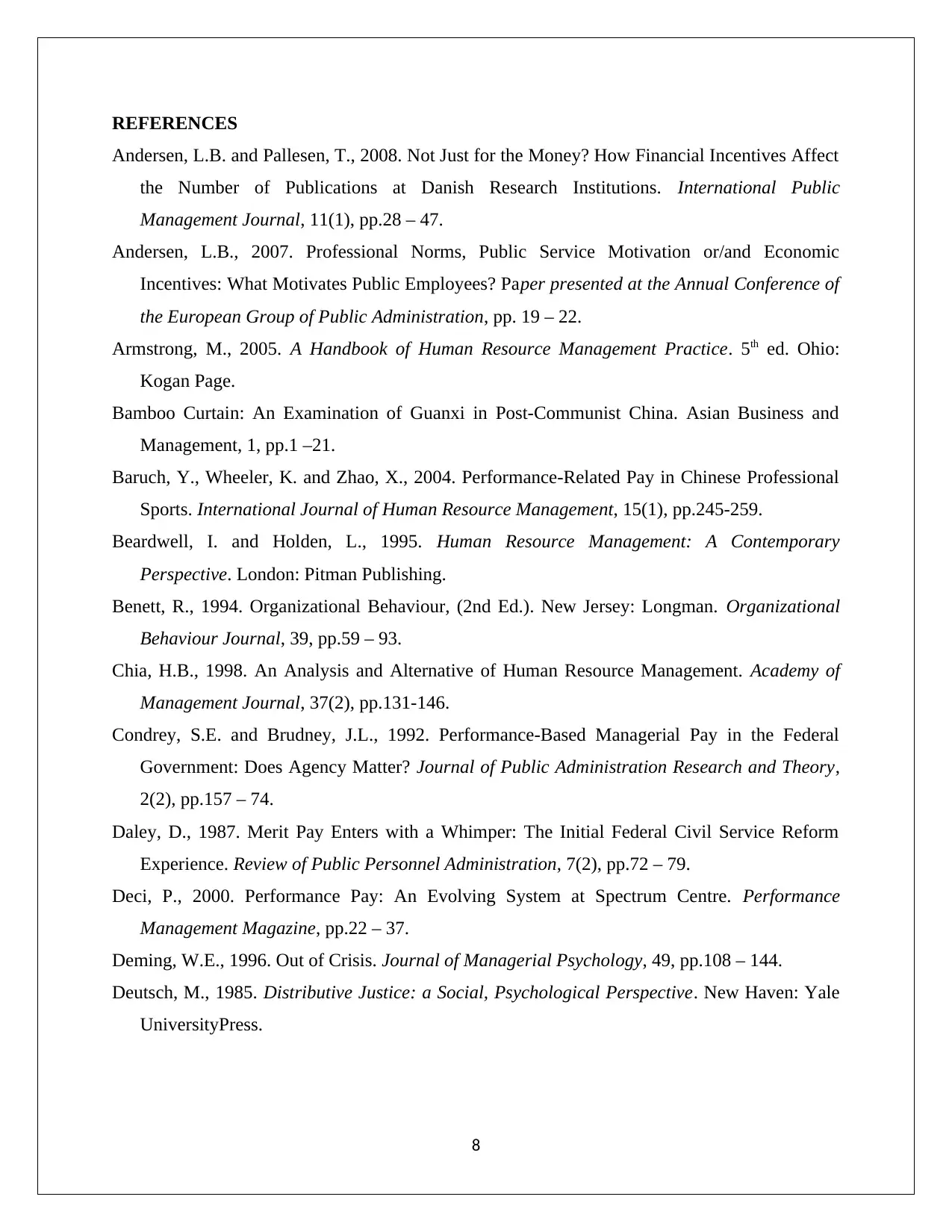
REFERENCES
Andersen, L.B. and Pallesen, T., 2008. Not Just for the Money? How Financial Incentives Affect
the Number of Publications at Danish Research Institutions. International Public
Management Journal, 11(1), pp.28 – 47.
Andersen, L.B., 2007. Professional Norms, Public Service Motivation or/and Economic
Incentives: What Motivates Public Employees? Paper presented at the Annual Conference of
the European Group of Public Administration, pp. 19 – 22.
Armstrong, M., 2005. A Handbook of Human Resource Management Practice. 5th ed. Ohio:
Kogan Page.
Bamboo Curtain: An Examination of Guanxi in Post-Communist China. Asian Business and
Management, 1, pp.1 –21.
Baruch, Y., Wheeler, K. and Zhao, X., 2004. Performance-Related Pay in Chinese Professional
Sports. International Journal of Human Resource Management, 15(1), pp.245-259.
Beardwell, I. and Holden, L., 1995. Human Resource Management: A Contemporary
Perspective. London: Pitman Publishing.
Benett, R., 1994. Organizational Behaviour, (2nd Ed.). New Jersey: Longman. Organizational
Behaviour Journal, 39, pp.59 – 93.
Chia, H.B., 1998. An Analysis and Alternative of Human Resource Management. Academy of
Management Journal, 37(2), pp.131-146.
Condrey, S.E. and Brudney, J.L., 1992. Performance-Based Managerial Pay in the Federal
Government: Does Agency Matter? Journal of Public Administration Research and Theory,
2(2), pp.157 – 74.
Daley, D., 1987. Merit Pay Enters with a Whimper: The Initial Federal Civil Service Reform
Experience. Review of Public Personnel Administration, 7(2), pp.72 – 79.
Deci, P., 2000. Performance Pay: An Evolving System at Spectrum Centre. Performance
Management Magazine, pp.22 – 37.
Deming, W.E., 1996. Out of Crisis. Journal of Managerial Psychology, 49, pp.108 – 144.
Deutsch, M., 1985. Distributive Justice: a Social, Psychological Perspective. New Haven: Yale
UniversityPress.
8
Andersen, L.B. and Pallesen, T., 2008. Not Just for the Money? How Financial Incentives Affect
the Number of Publications at Danish Research Institutions. International Public
Management Journal, 11(1), pp.28 – 47.
Andersen, L.B., 2007. Professional Norms, Public Service Motivation or/and Economic
Incentives: What Motivates Public Employees? Paper presented at the Annual Conference of
the European Group of Public Administration, pp. 19 – 22.
Armstrong, M., 2005. A Handbook of Human Resource Management Practice. 5th ed. Ohio:
Kogan Page.
Bamboo Curtain: An Examination of Guanxi in Post-Communist China. Asian Business and
Management, 1, pp.1 –21.
Baruch, Y., Wheeler, K. and Zhao, X., 2004. Performance-Related Pay in Chinese Professional
Sports. International Journal of Human Resource Management, 15(1), pp.245-259.
Beardwell, I. and Holden, L., 1995. Human Resource Management: A Contemporary
Perspective. London: Pitman Publishing.
Benett, R., 1994. Organizational Behaviour, (2nd Ed.). New Jersey: Longman. Organizational
Behaviour Journal, 39, pp.59 – 93.
Chia, H.B., 1998. An Analysis and Alternative of Human Resource Management. Academy of
Management Journal, 37(2), pp.131-146.
Condrey, S.E. and Brudney, J.L., 1992. Performance-Based Managerial Pay in the Federal
Government: Does Agency Matter? Journal of Public Administration Research and Theory,
2(2), pp.157 – 74.
Daley, D., 1987. Merit Pay Enters with a Whimper: The Initial Federal Civil Service Reform
Experience. Review of Public Personnel Administration, 7(2), pp.72 – 79.
Deci, P., 2000. Performance Pay: An Evolving System at Spectrum Centre. Performance
Management Magazine, pp.22 – 37.
Deming, W.E., 1996. Out of Crisis. Journal of Managerial Psychology, 49, pp.108 – 144.
Deutsch, M., 1985. Distributive Justice: a Social, Psychological Perspective. New Haven: Yale
UniversityPress.
8
⊘ This is a preview!⊘
Do you want full access?
Subscribe today to unlock all pages.

Trusted by 1+ million students worldwide
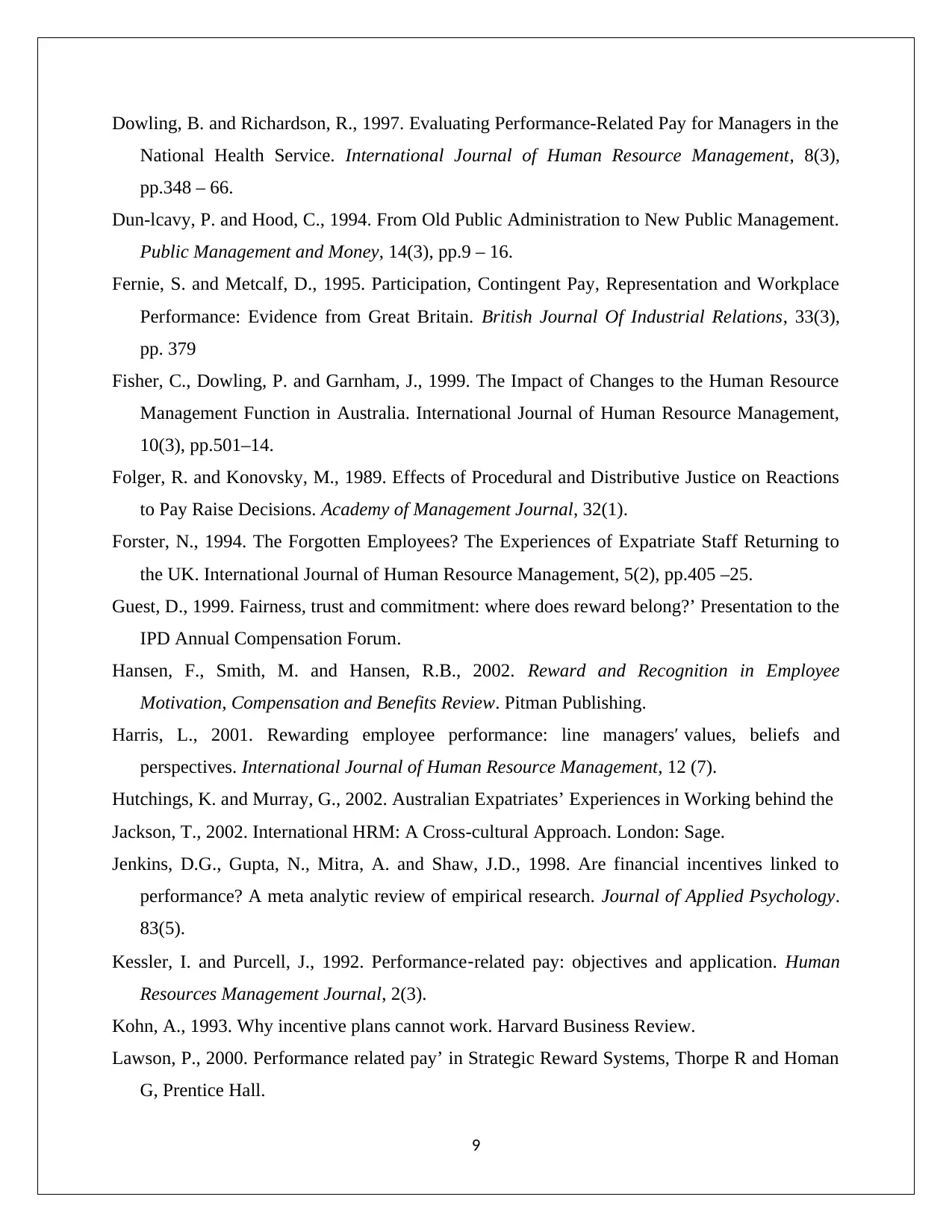
Dowling, B. and Richardson, R., 1997. Evaluating Performance-Related Pay for Managers in the
National Health Service. International Journal of Human Resource Management, 8(3),
pp.348 – 66.
Dun-lcavy, P. and Hood, C., 1994. From Old Public Administration to New Public Management.
Public Management and Money, 14(3), pp.9 – 16.
Fernie, S. and Metcalf, D., 1995. Participation, Contingent Pay, Representation and Workplace
Performance: Evidence from Great Britain. British Journal Of Industrial Relations, 33(3),
pp. 379
Fisher, C., Dowling, P. and Garnham, J., 1999. The Impact of Changes to the Human Resource
Management Function in Australia. International Journal of Human Resource Management,
10(3), pp.501–14.
Folger, R. and Konovsky, M., 1989. Effects of Procedural and Distributive Justice on Reactions
to Pay Raise Decisions. Academy of Management Journal, 32(1).
Forster, N., 1994. The Forgotten Employees? The Experiences of Expatriate Staff Returning to
the UK. International Journal of Human Resource Management, 5(2), pp.405 –25.
Guest, D., 1999. Fairness, trust and commitment: where does reward belong?’ Presentation to the
IPD Annual Compensation Forum.
Hansen, F., Smith, M. and Hansen, R.B., 2002. Reward and Recognition in Employee
Motivation, Compensation and Benefits Review. Pitman Publishing.
Harris, L., 2001. Rewarding employee performance: line managersʹ values, beliefs and
perspectives. International Journal of Human Resource Management, 12 (7).
Hutchings, K. and Murray, G., 2002. Australian Expatriates’ Experiences in Working behind the
Jackson, T., 2002. International HRM: A Cross-cultural Approach. London: Sage.
Jenkins, D.G., Gupta, N., Mitra, A. and Shaw, J.D., 1998. Are financial incentives linked to
performance? A meta analytic review of empirical research. Journal of Applied Psychology.
83(5).
Kessler, I. and Purcell, J., 1992. Performance‐related pay: objectives and application. Human
Resources Management Journal, 2(3).
Kohn, A., 1993. Why incentive plans cannot work. Harvard Business Review.
Lawson, P., 2000. Performance related pay’ in Strategic Reward Systems, Thorpe R and Homan
G, Prentice Hall.
9
National Health Service. International Journal of Human Resource Management, 8(3),
pp.348 – 66.
Dun-lcavy, P. and Hood, C., 1994. From Old Public Administration to New Public Management.
Public Management and Money, 14(3), pp.9 – 16.
Fernie, S. and Metcalf, D., 1995. Participation, Contingent Pay, Representation and Workplace
Performance: Evidence from Great Britain. British Journal Of Industrial Relations, 33(3),
pp. 379
Fisher, C., Dowling, P. and Garnham, J., 1999. The Impact of Changes to the Human Resource
Management Function in Australia. International Journal of Human Resource Management,
10(3), pp.501–14.
Folger, R. and Konovsky, M., 1989. Effects of Procedural and Distributive Justice on Reactions
to Pay Raise Decisions. Academy of Management Journal, 32(1).
Forster, N., 1994. The Forgotten Employees? The Experiences of Expatriate Staff Returning to
the UK. International Journal of Human Resource Management, 5(2), pp.405 –25.
Guest, D., 1999. Fairness, trust and commitment: where does reward belong?’ Presentation to the
IPD Annual Compensation Forum.
Hansen, F., Smith, M. and Hansen, R.B., 2002. Reward and Recognition in Employee
Motivation, Compensation and Benefits Review. Pitman Publishing.
Harris, L., 2001. Rewarding employee performance: line managersʹ values, beliefs and
perspectives. International Journal of Human Resource Management, 12 (7).
Hutchings, K. and Murray, G., 2002. Australian Expatriates’ Experiences in Working behind the
Jackson, T., 2002. International HRM: A Cross-cultural Approach. London: Sage.
Jenkins, D.G., Gupta, N., Mitra, A. and Shaw, J.D., 1998. Are financial incentives linked to
performance? A meta analytic review of empirical research. Journal of Applied Psychology.
83(5).
Kessler, I. and Purcell, J., 1992. Performance‐related pay: objectives and application. Human
Resources Management Journal, 2(3).
Kohn, A., 1993. Why incentive plans cannot work. Harvard Business Review.
Lawson, P., 2000. Performance related pay’ in Strategic Reward Systems, Thorpe R and Homan
G, Prentice Hall.
9
Paraphrase This Document
Need a fresh take? Get an instant paraphrase of this document with our AI Paraphraser

Lebby, A., 1993. Rethinking rewards. Harvard Business Review.
10
10
1 out of 11
Related Documents
Your All-in-One AI-Powered Toolkit for Academic Success.
+13062052269
info@desklib.com
Available 24*7 on WhatsApp / Email
![[object Object]](/_next/static/media/star-bottom.7253800d.svg)
Unlock your academic potential
Copyright © 2020–2025 A2Z Services. All Rights Reserved. Developed and managed by ZUCOL.





